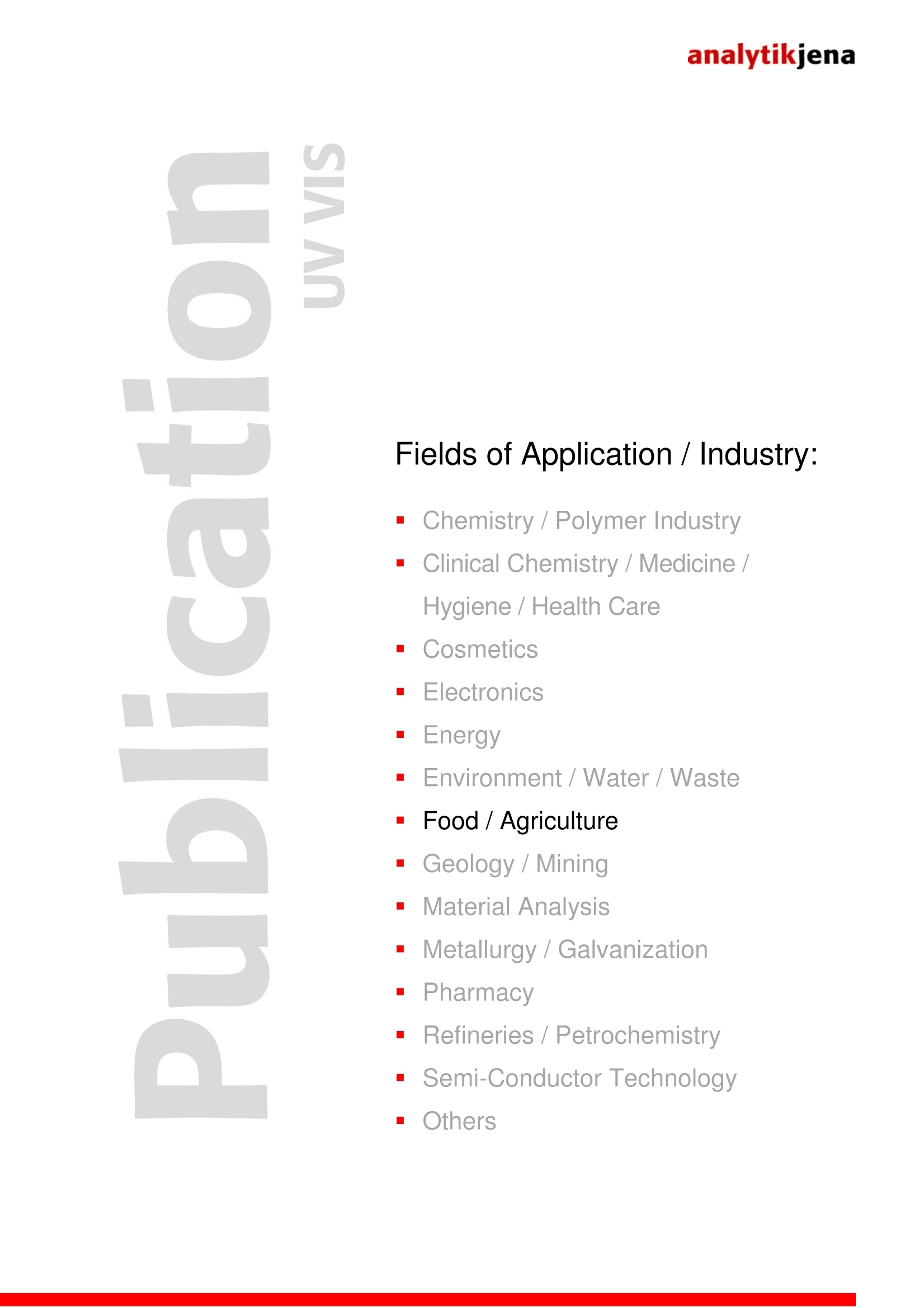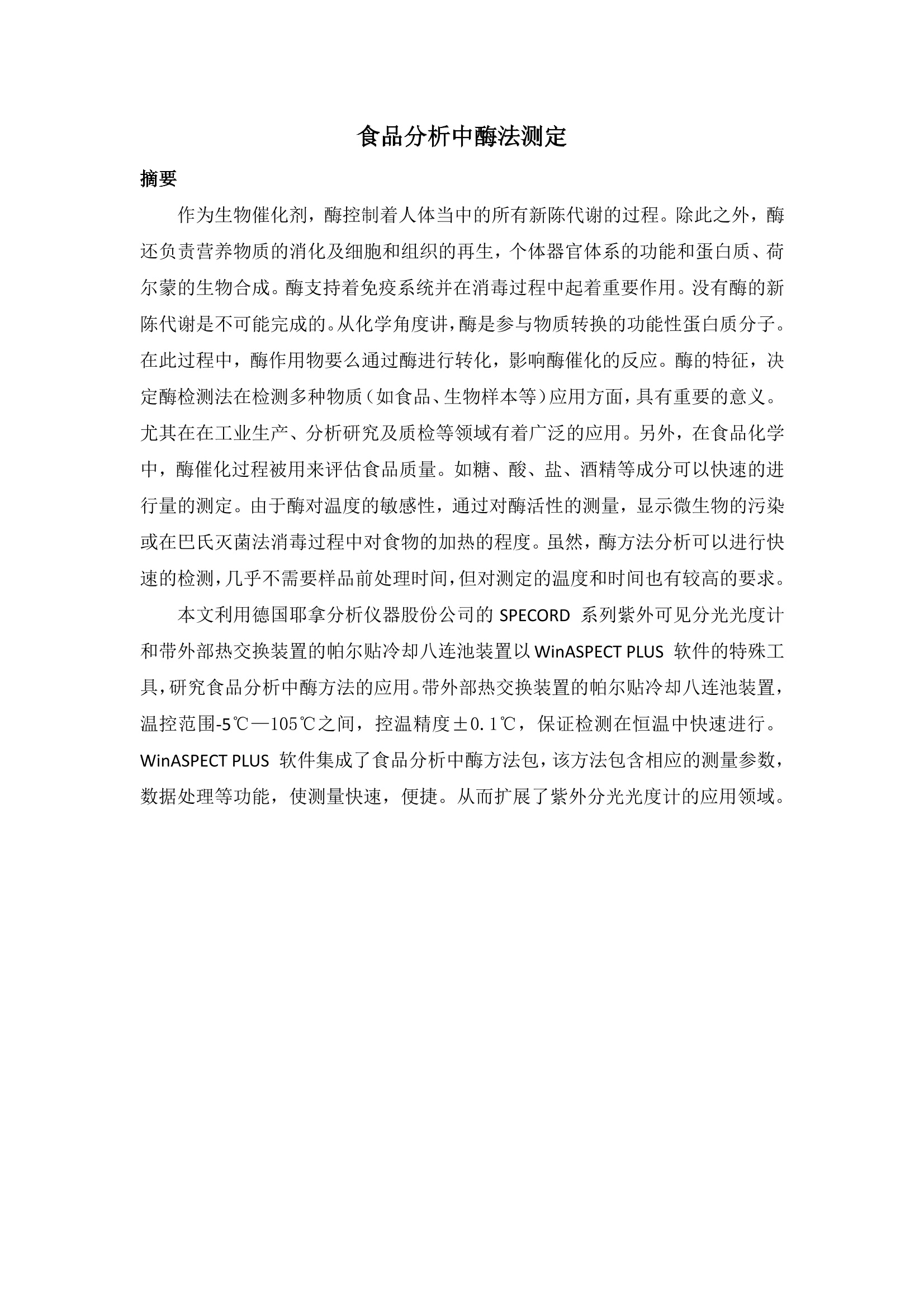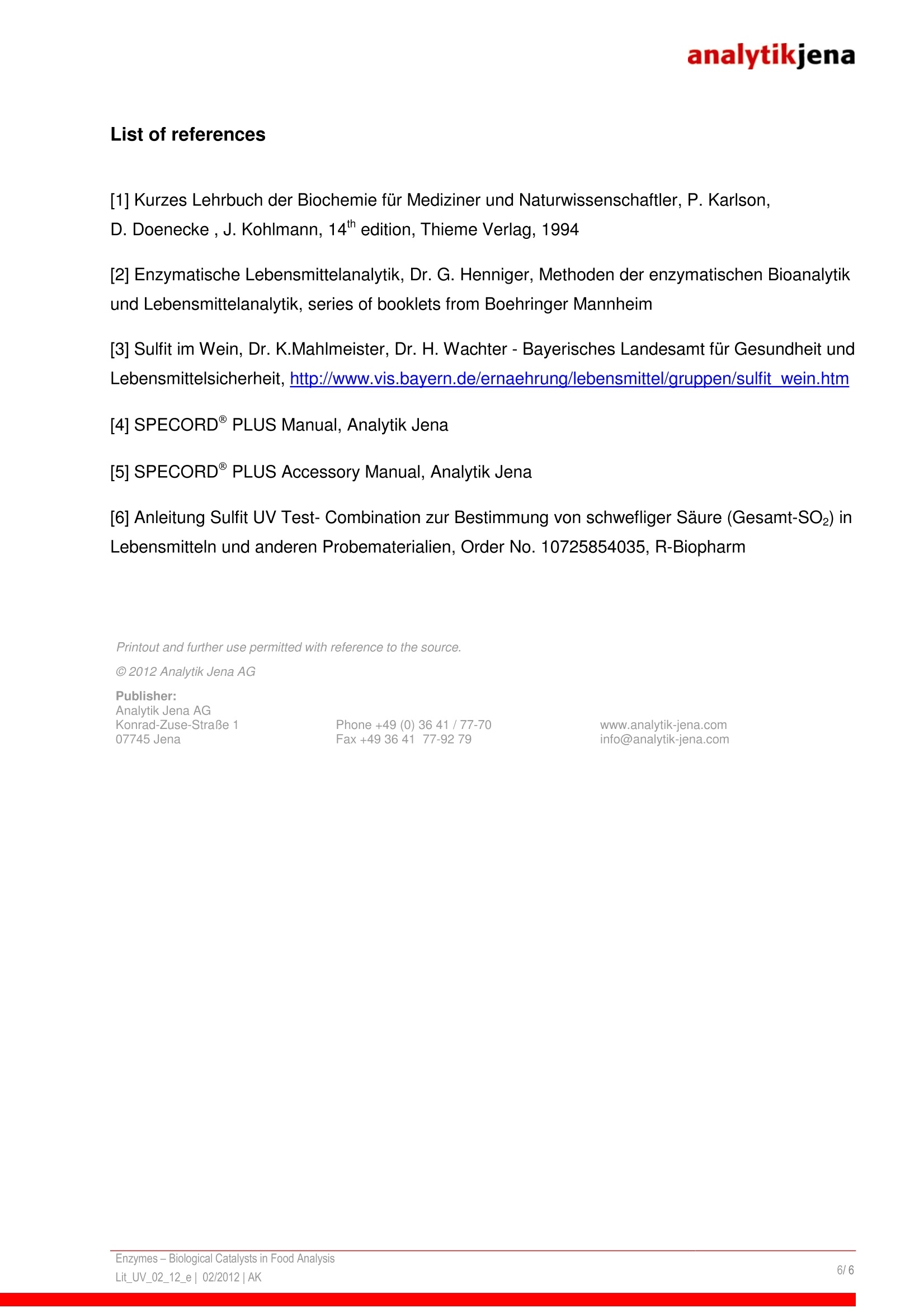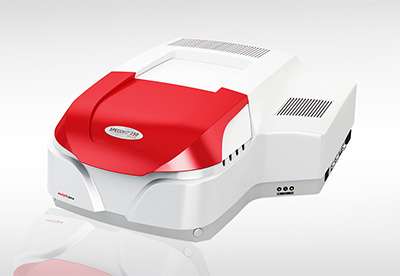方案详情
文
德国耶拿分析仪器股份公司的SPECORD 系列紫外可见分光光度计和带外部热交换装置的帕尔贴冷却八连池装置以WinASPECT PLUS 软件的特殊工具,研究食品分析中酶方法的应用。带外部热交换装置的帕尔贴冷却八连池装置,温控范围-5℃—105℃之间,控温精度±0.1℃,保证检测在恒温中快速进行。WinASPECT PLUS 软件集成了食品分析中酶方法包,该方法包含相应的测量参数,数据处理等功能,使测量快速,便捷。从而扩展了紫外分光光度计的应用领域。
方案详情

analytikjena Fields of Application / Industry: Chemistry / Polymer Industry Clinical Chemistry /Medicine/Hygiene / Health Care Cosmetics Electronics Energy Environment / Water / Waste Food / Agriculture Geology / Mining Material Analysis Metallurgy / Galvanization Pharmacy Refineries / Petrochemistry Semi-Conductor Technology Others 食品分析中酶法测定 摘要 作为生物催化剂,酶控制着人体当中的所有新陈代谢的过程。除此之外,酶还负责营养物质的消化及细胞和组织的再生,个体器官体系的功能和蛋白质、荷尔蒙的生物合成。酶支持着免疫系统并在消毒过程中起着重要作用。没有酶的新陈代谢是不可能完成的。从化学角度讲,酶是参与物质转换的功能性蛋白质分子。在此过程中,酶作用物要么通过酶进行转化,影响酶催化的反应。酶的特征,决定酶检测法在检测多种物质(如食品、生物样本等)应用方面,具有重要的意义。尤其在在工业生产、分析研究及质检等领域有着广泛的应用。另外,在食品化学中,酶催化过程被用来评估食品质量。如糖、酸、盐、酒精等成分可以快速的进行量的测定。由于酶对温度的敏感性,通过对酶活性的测量,显示微生物的污染或在巴氏灭菌法消毒过程中对食物的加热的程度。虽然,酶方法分析可以进行快速的检测,几乎不需要样品前处理时间,但对测定的温度和时间也有较高的要求。 本文利用德国耶拿分析仪器股份公司的 SPECORD 系列紫外可见分光光度计和带外部热交换装置的帕尔贴冷却八连池装置以 WinASPECT PLUS 软件的特殊工具,研究食品分析中酶方法的应用。带外部热交换装置的帕尔贴冷却八连池装置,温控范围-5℃一105℃之间,控温精度±0.1℃,保证检测在恒温中快速进行。WinASPECT PLUS 软件集成了食品分析中酶方法包,该方法包含相应的测量参数,数据处理等功能,使测量快速,,便捷。从而扩展了紫外分光光度计的应用领域。 Enzymes- Biological Catalysts in Food Analysis Alexandra Kastner, Application Chemist Molecule Spectroscopy, Analytik Jena AG,Analytical Instrumentation, Konrad-Zuse-Str. 1, 07745 Jena Introduction As biological catalysts, enzymes control all metabolic processes in the human organism. They are,among other things, responsible for the digestion of nutrients, the regeneration of cells and tissue,the function of individual organ systems and for the biosynthesis of proteins as well as hormones.They support the immune system and are involved in detoxification processes. Without enzymesall metabolic processes would be impossible. From a chemical point of view they are proteinmolecules with functional groups which interact with the substance to be analyzed (the substrate)and on which the substance conversion is performed. During this, the substrate is either converteditself via the enzyme or it influences the enzyme-catalyzed reaction. Enzymes have a distinctiveselectivity for binding certain molecules and always catalyze a defined reaction, e.g. hydrolysis,oxidation/reduction or rearrangement, which can be deviated from its name (e.g. hydrolase,oxidase). [1] Because of these characteristics, enzymatic methods offer significant benefitscompared to the chemical processes when examining countless materials such as food, biologicalsamples and many others. They are used in different areas of the industry, research and official monitoring. In food chemistry, enzymatic processes are used to evaluate foods. Ingredients, such as sugar,acids and their salts, alcohol or other substances, can quickly be determined quantitatively evenfrom complex matrices by performing the relevant sample preparation. Furthermore measurementsof the activity of certain enzymes give an indication of microbial pollution or can be used to test asufficient heating of foods during pasteurization or sterilization processes because of theirsensitivity to heat [2]. Experimental In the following application example the concentration of sulfite in white wine is determined usingenzymatic determination. Sulfite or sulfur dioxide is e.g. added to wine as antioxidant andpreservative or to bind fermentation by-products which would have a negative impact on the taste.The total amount of sulfur dioxide (total of bound and free SO2) that wine may contain is limited by an EU regulation and depends on the type, the quality level as well as the sugar content of thewine.[3] For the measurement the SPECORD 210 PLUS with a Peltier-tempered 8-cell changer withexternal heat exchanger was used. (Fig. 1) The SPECORD 210 PLUS is a double-beamphotometer for the wavelength range of 190-1100 nm, with 4-fold variable spectral slit width andtwo tempered photo diodes (CDD-Cooled Double Detection). [4] The Peltier-tempered 8-cellchanger is an autosampler with 8 positions for cells with a path length of 10 mm (Fig. 2). It enablesenzymatic analyses of multiple samples which require very exact tempering. The cell block isconnected to an external heat exchanger via hoses, which is used to cool the back of the Peltierelement. The temperature control is performed by a separate control unit, for which thetemperature can be controlled in a range between -5℃ and +105℃ with an accuracy of +0.1℃.A measurement sensor is used as control sensor and positioned at the bottom outer corner of thecell block. The cell changer further features two additional sensors for the registration of the holderor inside cell temperature respectively.A measurement sensor is used for the direct control of theinside cell temperature which can remain in the cell during the optical measurement. [5] The enzymatic reactions are performed in several steps. In the first step of the reaction the sulfite(SO3) is oxidized in the presence of oxygen by the enzyme sulfite oxidase (SO2-OD) to sulfate(SO4 ) (1). Hydrogen peroxide (H2O2) which is created in this step is converted in the second stepwith reduced NADPH by the enzyme NADPH peroxidase (NADPH-POD) to water and NAD*(2).The amount of used NADH is measured photometrically at 340 nm and is equivalent to the sulfiteconcentration.[6] A test combination of R-Biopharm [6] and the sulfite method of the WinASPECT PLUS softwarewere used for the determination of the concentration of sulfite, which is performed at a temperatureof 25℃. The white wine did not require any further sample preparation and could be used with0.1 ml directly with the reaction solutions for the measurement. According to the instruction of thetest kit 1.0 ml of the reaction mixture 2 (consisting of triethanolamine buffer and NADPH) wasplaced into the cells,mixed for the blank value with 2.0ml distilled water, for the sample with 1.9 mldistilled water and then 0.01 ml of suspension 3 (consisting of NADH-POD) were added. Thereference measurement was performed with water. All reagents were mixed with a stirring spatula and after an incubation period of 5min the absorbance E could be measured. The enzymaticreaction was started by adding 0.05 ml of the suspension 4 (SO2-OD).After a further incubationperiod of 30 min the second absorbance(E2) was measured. Additionally a sulfite control standardwas measured to check the accuracy of the analysis. The processing of the total method isperformed automatically by the WinASPECT PLUS@ software. Results and evaluation The absorbance differences for the blank value and the samples are calculated to determine theconcentration of sulfite. Afterwards the absorbance difference of the blank value is subtracted fromthe absorbance differences of the samples: The sulfite concentration is calculated according to the general formula: whereby V =Test volume ml V =Sample volume ml MG =Molecular weight of the substance to be determined [g/ mol]so64.06 g/mol d = Path length of the cell cm E =Absorption coefficient of NADH at 340 nm=6.3 l·mmolcm The calculation of the absorbance differences and the sulfite concentration are performedautomatically by the software after the measurement. A concentration of sulfite of 60.1 mg/I wasdetermined for the white wine sample. The maximum quantity of sulfur dioxide in white wine withless than 5 g residual sugar/l is 200 mg/l. According to the Food Labeling Directive of the EU wineswhich contain a concentration of more than 10 mg/I SO2 have to be labeled because sulfitebelongs to the allergenic substances. Any wine naturally includes SO2 which is produced in lowconcentrations (up to 40 mg/l) under normal, physiological conditions during fermentation. [3] Summary Because of their effect and substance specificity the enzymes enable a number of simultaneousmetabolic processes in the human organism. In the routine analysis enzymatic methods aretherefore of great importance. By the measurement of the absorbance change in the UV range ofabsorbent coenzymes nearly all substances which can be converted by enzymes can bedetermined photometrically. An enzyme-based analysis is fast and can be performed without time-consuming samplepreparation. It is performed under physiological conditions. The reagents are harmless and easy tohandle. Furthermore the documentation of individual substances in mixtures is possible. Thanks toan extensive collection of enzymatic methods in the WinASPECT PLUS software, thedetermination of the corresponding substance with the relevant measurement setting, samplesequence and evaluation is performed automatically. SPECORDQ PLUS accessories: Fig. 1 SPECORDPLUS with Peltier-temperedcell holder with external heat exchanger Fig. 2 Peltier-tempered 8-cell changer List of references [1] Kurzes Lehrbuch der Biochemie fur Mediziner und Naturwissenschaftler, P. Karlson, D. Doenecke, J. Kohlmann, 14" edition, Thieme Verlag, 1994 [2] Enzymatische Lebensmittelanalytik, Dr. G. Henniger, Methoden der enzymatischen Bioanalytikund Lebensmittelanalytik, series of booklets from Boehringer Mannheim [3] Sulfit im Wein, Dr. K.Mahlmeister, Dr. H. Wachter-Bayerisches Landesamt fur Gesundheit undLebensmittelsicherheit, http://www.vis.bayern.de/ernaehrung/lebensmittel/gruppen/sulfit wein.htm [4]SPECORD PLUS Manual, Analytik Jena [5] SPECORD PLUS Accessory Manual, Analytik Jena [6] Anleitung Sulfit UV Test- Combination zur Bestimmung von schwefliger Saure (Gesamt-SO2) inLebensmitteln und anderen Probematerialien, Order No. 10725854035, R-Biopharm Printout and further use permitted with reference to the source. C 2012 Analytik Jena AG Publisher: Analytik Jena AG Konrad-Zuse-StraBe 1 07745 Jena Phone +49 (0) 36 41/77-70Fax +49 36 41 77-92 79 Enzymes-Biological Catalysts in Food AnalysisLit_UV_e|| AK/
确定







还剩5页未读,是否继续阅读?
耶拿分析仪器(北京)有限公司为您提供《食品中酶检测方案 》,该方案主要用于食醋中理化分析检测,参考标准--,《食品中酶检测方案 》用到的仪器有SPECORD 200PLUS紫外可见分光光度计 、SPECORD 210 PLUS紫外可见分光光度计 、SPECORD 250 PLUS紫外可见分光光度计 、德国耶拿紫外可见分光光度计 SPECORD 50 PLUS
相关方案
更多
该厂商其他方案
更多













